 Facebook
Facebook
 X
X
 Instagram
Instagram
 TikTok
TikTok
 Youtube
Youtube
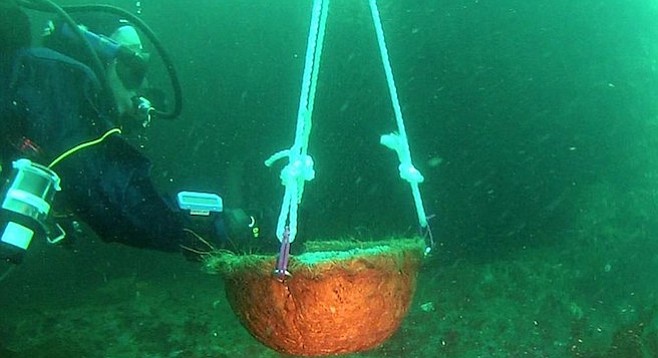
In 2011, a tight-knit group of divers lost a dear friend. Jim had died doing what he loved best: diving. So, after his memorial, we’d planned to scatter a portion of his ashes at sea, from a boat.
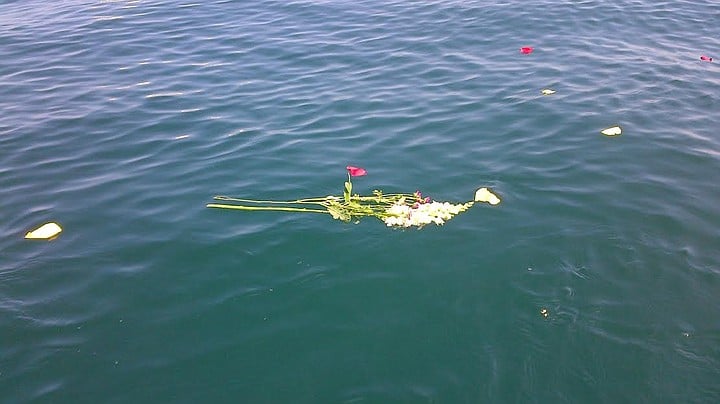
But, we wanted to come up with a more creative way of disposing of his ashes.
Jim was a special kind of diver, a technical diver who used exotic gas mixes to go to depths well below recreational limits (+200 feet). He was also a solo diver who used an underwater scooter to propel himself along the bottom and explore areas the rest of us dared not go.
So, we thought, what would be the most fitting way to lay our friend to rest? Well, underwater, of course! But, where?
We had recently made contact with an ocean-related nonprofit called TerraMar, one of whose self-appointed tasks is to “sell” parcels of the ocean to help increase awareness of the ocean’s current ecological plight, over-fishing, acidification, warming temperatures, etc.
So, we thought we’d purchase a “plot” of ocean off the coast of Point Loma and name it after our friend Jim, whose nickname was “NOAA Jim,” because of his former employment with that federal agency.
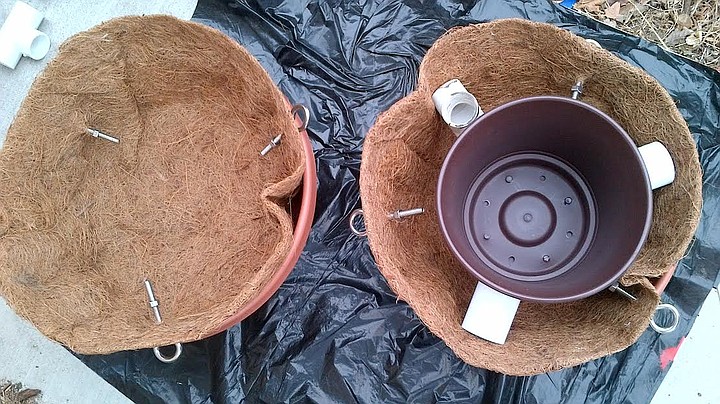
The next step was to encase Jim’s ashes in a suitable, environmentally friendly container that would survive the ages underwater (we hoped). My friend Barbara took care of that , spending a couple days getting it just right.
She eventually decided to use garden potting materials to make a couple cement “bundts”: a 14" round plastic planter (dome shaped), a 14" pre-molded coco liner, and a 10" plastic planter. Eye hooks, PVC pipe fittings, fast-setting concrete mix, and a five-gallon bucket were also picked up at the home-improvement store.
“The ratio of concrete to water to ash was a guess,” says Barbara. “I filled the five-gallon bucket about a quarter full with concrete and emptied about a quart-sized ziploc baggie of ashes and mixed the water to the proper consistency. I think each weighed about 20 to 30 pounds when done…. Because of the weight and the available materials, I chose to make two. The plastic planters were removed before putting them into the water.”
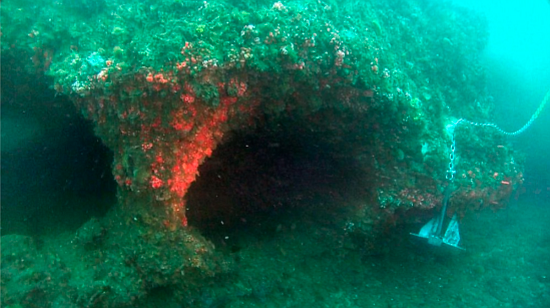
Once that was done, our friend Steve took us out in his boat one sunny day and we began looking for a suitable spot to place the two containers with his ashes.
Steve had already scouted out a possible location beforehand and named it Kinane Pass, after our friend’s last name. So, we rolled into the water to look for a suitable spot for the containers.
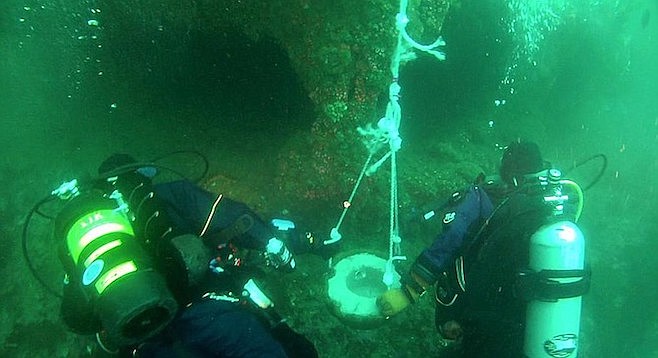
We hadn’t been down for more than a few minutes when he found a perfect little grotto at around 85 feet that even had a small geological pillar or post that sectioned it off into two spots: one for each container.
The next phase was a bit more complicated, because the cement containers were quite heavy (even underwater), so we had to devise a system using air-filled “lift bags” to offset the weight of the containers to enable us to maneuver them down to depth and into the grotto itself. Eventually, with a bit of grunting, pushing, and pulling, and with Steve supervising the operation, we got them placed into the little cave.
Barbara gently kissed the containers after they were situated. Then we all paused in our exertions to remember why were were down there, and each said goodbye to him in our own way.
I’m sure Jim would’ve been the first to laugh at our jokes about maneuvering the cement bundt cakes into place and all the comical grunting and frantic underwater gesticulating that occurred.
And, there his ashes remain, sitting in the little grotto, hopefully for many years to come. We have no illusions about eternity, given the erosive power of the ocean over time. But, we felt that it was a perfect resting spot for one who loved the ocean so. Our friend Steve has the spot marked on his GPS device. We promised Jim to come visit him often.
Michael Bear is citizen science project director at Ocean Sanctuaries in San Diego, a nonprofit that promotes marine citizen science.


In 2011, a tight-knit group of divers lost a dear friend. Jim had died doing what he loved best: diving. So, after his memorial, we’d planned to scatter a portion of his ashes at sea, from a boat.

But, we wanted to come up with a more creative way of disposing of his ashes.
Jim was a special kind of diver, a technical diver who used exotic gas mixes to go to depths well below recreational limits (+200 feet). He was also a solo diver who used an underwater scooter to propel himself along the bottom and explore areas the rest of us dared not go.
So, we thought, what would be the most fitting way to lay our friend to rest? Well, underwater, of course! But, where?
We had recently made contact with an ocean-related nonprofit called TerraMar, one of whose self-appointed tasks is to “sell” parcels of the ocean to help increase awareness of the ocean’s current ecological plight, over-fishing, acidification, warming temperatures, etc.
So, we thought we’d purchase a “plot” of ocean off the coast of Point Loma and name it after our friend Jim, whose nickname was “NOAA Jim,” because of his former employment with that federal agency.

The next step was to encase Jim’s ashes in a suitable, environmentally friendly container that would survive the ages underwater (we hoped). My friend Barbara took care of that , spending a couple days getting it just right.
She eventually decided to use garden potting materials to make a couple cement “bundts”: a 14" round plastic planter (dome shaped), a 14" pre-molded coco liner, and a 10" plastic planter. Eye hooks, PVC pipe fittings, fast-setting concrete mix, and a five-gallon bucket were also picked up at the home-improvement store.
“The ratio of concrete to water to ash was a guess,” says Barbara. “I filled the five-gallon bucket about a quarter full with concrete and emptied about a quart-sized ziploc baggie of ashes and mixed the water to the proper consistency. I think each weighed about 20 to 30 pounds when done…. Because of the weight and the available materials, I chose to make two. The plastic planters were removed before putting them into the water.”

Once that was done, our friend Steve took us out in his boat one sunny day and we began looking for a suitable spot to place the two containers with his ashes.
Steve had already scouted out a possible location beforehand and named it Kinane Pass, after our friend’s last name. So, we rolled into the water to look for a suitable spot for the containers.

We hadn’t been down for more than a few minutes when he found a perfect little grotto at around 85 feet that even had a small geological pillar or post that sectioned it off into two spots: one for each container.
The next phase was a bit more complicated, because the cement containers were quite heavy (even underwater), so we had to devise a system using air-filled “lift bags” to offset the weight of the containers to enable us to maneuver them down to depth and into the grotto itself. Eventually, with a bit of grunting, pushing, and pulling, and with Steve supervising the operation, we got them placed into the little cave.
Barbara gently kissed the containers after they were situated. Then we all paused in our exertions to remember why were were down there, and each said goodbye to him in our own way.
I’m sure Jim would’ve been the first to laugh at our jokes about maneuvering the cement bundt cakes into place and all the comical grunting and frantic underwater gesticulating that occurred.
And, there his ashes remain, sitting in the little grotto, hopefully for many years to come. We have no illusions about eternity, given the erosive power of the ocean over time. But, we felt that it was a perfect resting spot for one who loved the ocean so. Our friend Steve has the spot marked on his GPS device. We promised Jim to come visit him often.
Michael Bear is citizen science project director at Ocean Sanctuaries in San Diego, a nonprofit that promotes marine citizen science.
Comments